


Illustration: Sébastien Thibault
Science in the United States has never been stronger by most measures.
Over the past five years, the nation has won more scientific Nobel prizes than the rest of the world combined — in line with its domination of the prizes since the middle of the twentieth century. In 2020, two US drug companies spearheaded the development of vaccines that helped to contain a pandemic. Two years later, a California start-up firm released the revolutionary artificial-intelligence (AI) tool ChatGPT and a national laboratory broke a fundamental barrier in nuclear fusion.
This year, the United States is on track to spend US$1 trillion on research and development (R&D), much more than any other country. And its labs are a magnet for researchers from around the globe, with workers born in other nations accounting for 43% of doctorate-holders in the US workforce in science, technology, engineering and medicine (STEM).
US election debate: what Harris and Trump said about science
But as voters go to the polls in November to elect a new president and Congress, some scientific leaders worry that the nation is ceding ground to other research powerhouses, notably China, which is already outpacing the United States on many of the leading science metrics. “US science is perceived to be — and is — losing the race for global STEM leadership,” said Marcia McNutt, president of the US National Academy of Sciences in Washington DC, in a speech in June.
Concerns range from funding limitations for R&D and the growing politicization of science to heated debates about immigration. This has created “a perception that the United States is increasingly hostile to foreigners”, the US National Academies of Sciences, Engineering and Medicine (NASEM) reported in August1, warning that the United States “can no longer take for granted that it will remain the destination of choice for the world’s best and brightest”. The academies called for a government-wide effort to attract and retain international talent and improve STEM education at home.
The future of US science hinges, in no small way, on the November election. Together, the next president and Congress will play a pivotal part in setting the course for the US scientific enterprise for years to come by establishing funding plans, immigration policies and national-security measures that affect international collaboration.
Given the concerns over US leadership in science, how does the country measure up and what comes next after the election? Nature examines the numbers and a few key issues that could determine the United States’ scientific future.
The driving force behind research is money, and the United States has long enjoyed a leading position in science and technology in large part because it outspends all other nations. Combining government and private funding, the United States spent $923 billion in 2022 (the last year for which full numbers are available), or around 30% of global R&D spending.
But as China’s economy has soared, so has its R&D spending, to the equivalent of $812 billion (adjusted for purchasing power parity). On that trajectory it will draw level with the United States before 2030 (see ‘Research funding race’).
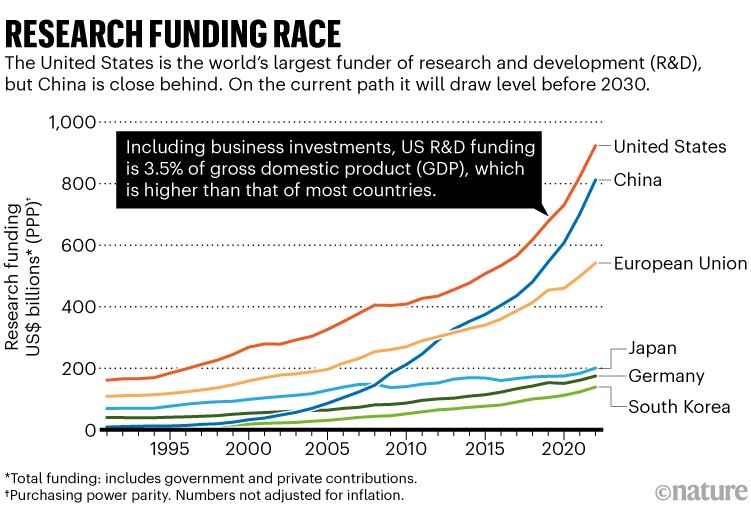
Source: OECD/MSTI
On sheer numbers of personnel, scientific output and patents, the United States has already lost its lead. In 2016, China leaped ahead as the top producer of science and engineering articles. In 2019, it passed the United States in the number of science and engineering PhDs awarded; and in 2021, it became top dog in international patent applications, according to a report by the US National Science Foundation (NSF) published in March2.
For years, some researchers who study science metrics have argued that China still lagged behind in terms of the quality of its scientific output, but that is also changing. In 2020, for instance, China overtook the United States in terms of its share of the world’s top 1% cited papers, a proxy measure of high-impact work, according to numbers from the Web of Science database (see ‘Top-cited research’).
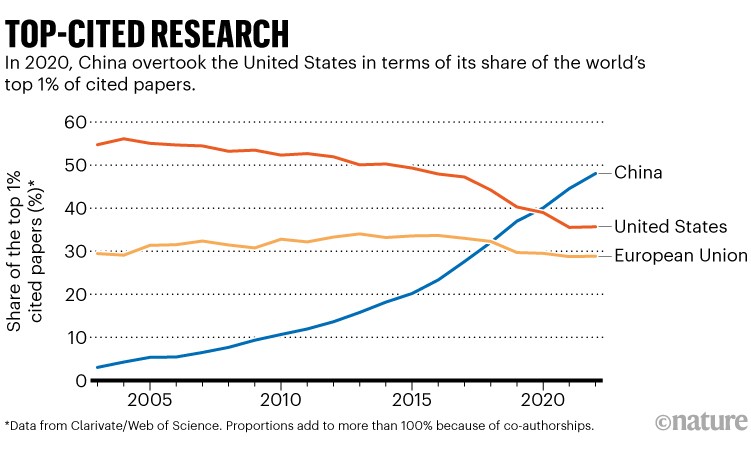
Source: Clarivate/Web of Science
China showed particular strengths in engineering, chemistry and materials science, whereas the United States retained its lead in areas such as biology and medicine (see ‘Who leads in various fields of science?’).
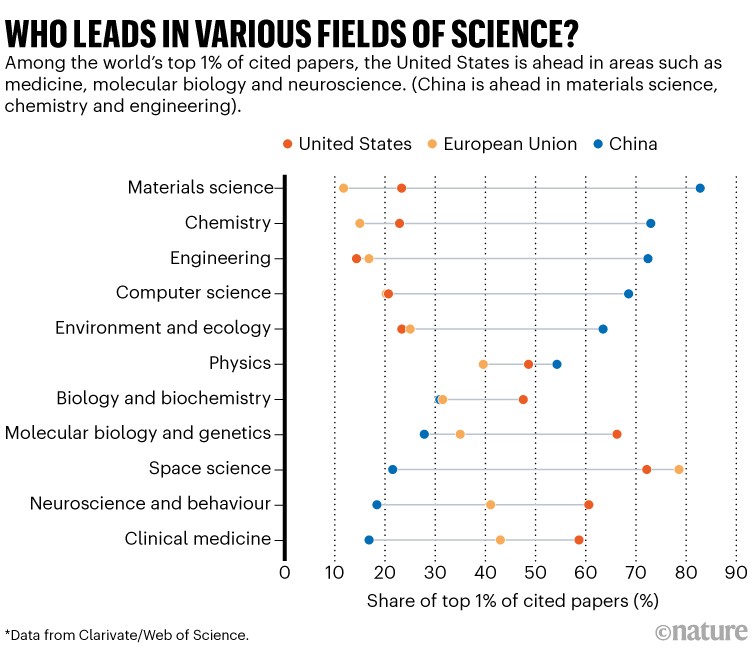
Source: Clarivate/Web of Science
Citation statistics are imperfect measures of influence: a study this year found that researchers in China show the greatest ‘home bias’, that is, disproportionately citing work from their own country3. Adjusting for this bias dents China’s progress — perhaps nudging it down to fourth in the world, the study suggested — but it doesn’t hugely change its direction of travel.
There are other signs of rising quality in China relative to other nations. Last year, it surpassed the United States in terms of papers that appeared in influential journals (see ‘Share of work in influential journals’).
Does it matter whether China or the United States is on top? Some political rhetoric frames these trends as essentially a zero-sum game. But in research, one country’s gain is not necessarily another’s loss, says Caroline Wagner, a research-policy specialist at the Ohio State University in Columbus.
The highest-cited papers of all come from US, Chinese and European researchers working together, she says. If China, or any other country, is pouring more money into research, this should benefit the United States — as long as it retains world-leading scientists who can tap into global innovation, and keeps its own research funding and quality high, says Kieron Flanagan, a research-policy analyst at the University of Manchester, UK.
The current alarms about US science echo similar warnings that have rippled through policy circles about once a generation. In 2005, for example, the National Academies published a dire report called Rising Above the Gathering Storm that cautioned about threats to US competitiveness from globalization4.
How Trump damaged science — and why it could take decades to recover
One recommendation from the report was to double the amount of basic research funding for mathematics, engineering and physical sciences, in line with the doubling of the budget for the National Institutes of Health that was accomplished between 1998 and 2003. The US Congress, which sets funding levels, passed a law in 2007 promising to do just that — but lawmakers didn’t follow through.
History is now repeating itself. In 2022, this time with an eye on China, Congress united to pass the CHIPS and Science Act, which authorized $280 billion to promote the domestic semiconductor industry and boost the budgets of several major research agencies. A key beneficiary of the legislation, the NSF, saw its budget increase by 11% to $9.9 billion in 2023 — only to fall back to $9.1 billion when Congress finalized this year’s budget.
As a share of gross domestic product (GDP), public investments in the NSF, the US Department of Energy’s Office of Science and the US National Institutes of Standards and Technology — all major funders of basic research in the physical sciences — are now lower than they have been at any time since 1997, according to Matt Hourihan, associate vice-president for government relations and public policy at the Association of American Universities in Washington DC (see ‘Falling federal research intensity’). US research investment as a share of GDP is still rising — but that is because R&D investment from private businesses is picking up the slack.
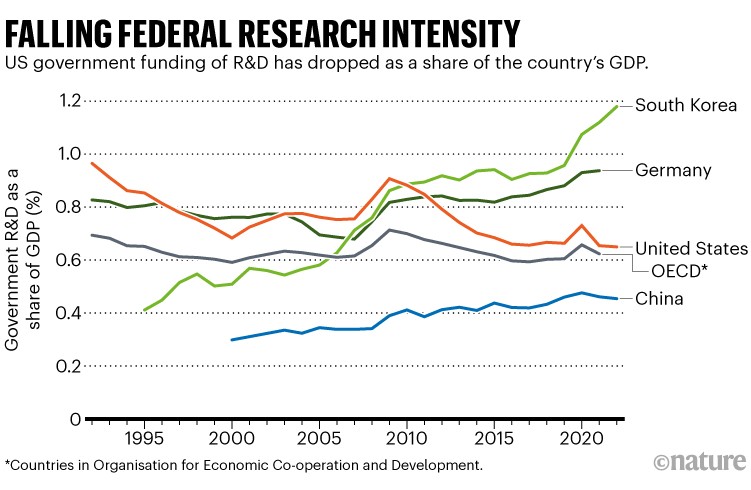
Source: OECD/MSTI
“We absolutely have to get federally funded R&D back on a healthier track,” says Arati Prabhakar, science adviser to US President Joe Biden and director of the White House Office of Science and Technology Policy (OSTP). The sharp uptick in private R&D is good for jobs and the economy, but it is no substitute for the kind of basic science that federal investments support, she told Nature.
Indeed, these trends explain the shifting balance of power between the United States and China, says Jonathan Adams, chief scientist at the Institute of Scientific Information, a unit of the analytics firm Clarivate, who is based in London. Adams points out that the United States retains its lead in areas that it has invested in the most, such as biomedical research. By contrast, China is overtaking the United States in materials science, physical sciences and computer science, which are areas where US investments have fallen short.
The question, come January, is whether the next president and Congress will work together to advance scientific funding commitments that both political parties have endorsed in the past. This depends in large part on who controls the two chambers of Congress, which is currently divided, with Democrats holding the Senate and Republicans having a majority in the House of Representatives.
Biden seeks to boost science funding — but his budget faces an ominous future
When it comes to setting spending priorities, Congress often goes its own way no matter what presidents propose in their budgets. For example, although previous president Donald Trump repeatedly sought to cut science budgets, it was during his tenure that Congress broke its own self-imposed budget caps and gave science agencies a significant boost in funding alongside the increases in defence spending sought by the Trump administration, says Jennifer Zeitzer, who leads the public-affairs office at the Federation of American Societies for Experimental Biology in Rockville, Maryland.
Today, lawmakers are once again operating under a budget agreement that seeks to cap overall spending until 2025, which could make it difficult to increase STEM spending, but it’s unclear how that discussion will play out with a new president and Congress next year.
“I call it the whiplash effect,” says Zeitzer. Funding agencies are constantly buffeted by shifting political winds that produce big promises — and occasionally big investments — before an inevitable swing back towards austerity. Half of the time, funding agencies are operating under provisional budgets and the looming threat of a government shutdown. “I don’t know how we’re supposed to be competitive if we’re facing another 20 years of this,” Zeitzer says.
Because the United States relies heavily on international talent to fuel its scientific engine, a key question is whether it will remain the preferred place for researchers globally to study and work. There are different ways to interpret the data.
The United States relies ever more heavily on overseas researchers: more than one-third of science and engineering PhDs granted last year went to international students (those on temporary visas), with the share at 59% in computer science (see ‘US reliance on overseas talent’). “We are at an all-time high in terms of dependency on foreign talent,” says Darío Gil, director of research at the technology giant IBM in Yorktown Heights, New York, and current chair of the US National Science Board, which oversees the NSF.
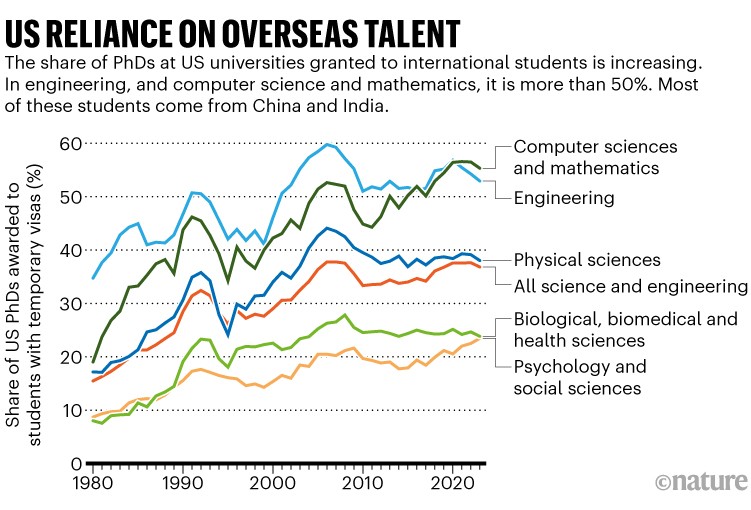
Source: NCSES
Most of these students come from China and India, which is a distant second. And when asked, 77% of Chinese students who earned doctoral degrees in the United States said that they intended to stay in the country, according to 2022 data, a proportion that has dipped only slightly over the previous five years.
More generally, the United States remains the world’s top venue for international students, according to data from the Organisation for Economic Co-operation and Development5, hosting 15% of all students worldwide in 2020, the latest comparative figures available.
But there are signs that the United States might be losing its edge. Its share of international students is declining, down from 23% in 20005. And although enrolment numbers have recovered to an all-time high after a brief pandemic dip (see ‘International students on the rebound’), there remains a question about whether top talent from China continues to view the United States as an attractive destination.
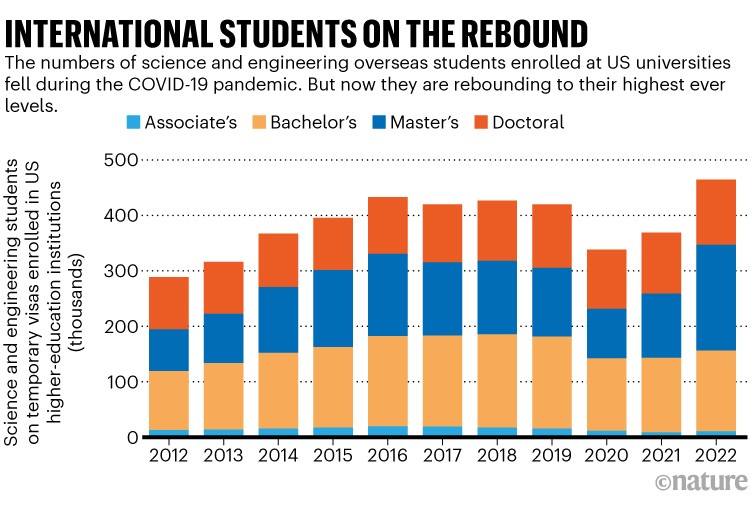
Source: ref. 2
China is still the United States’ biggest research collaborator, but the number of articles co-authored by Chinese and US researchers is falling — even as Chinese collaborations with competitors rise (see ‘US–China collaboration is dropping’).
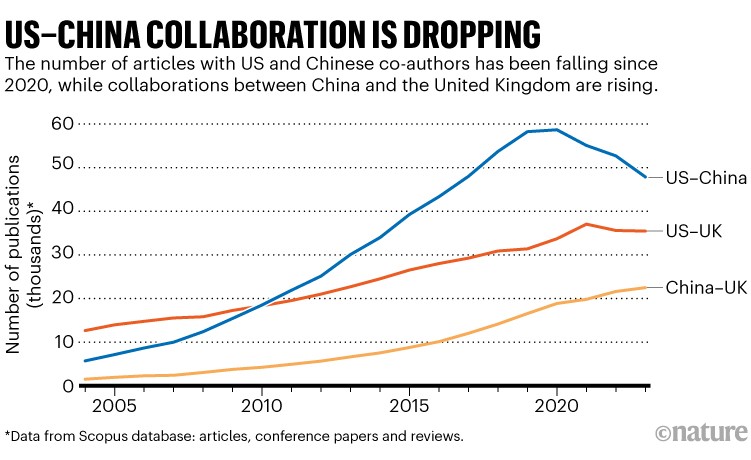
Source: Scopus
Some lawmakers in Congress might welcome this trend. Citing the dangers of letting science that is funded by US taxpayers fall into the hands of the Chinese military, congressional Republicans are pushing legislation that would limit the kind of research collaborations that university researchers can pursue.
Questions about immigration and research security came to a head when Trump occupied the White House. First came the temporary travel ban that mainly impacted citizens from several Muslim-majority countries. Then a federal crackdown on academic espionage, dubbed the China Initiative, drew accusations of racism after ensnaring scholars with links to China, including many US citizens of Chinese descent.
Biden ultimately ended both policies, but many scholars say they could make a comeback if Trump prevails in November. Last month, Trump vowed to reinstate his travel ban, and Republicans who control the US House of Representatives have approved legislation that would, if enacted, essentially reinstate the China Initiative.
These tensions might be taking a toll: surveys in the United States have found that many Chinese researchers worry about prejudice after the China Initiative. A study6 published this year examined the propensity of Chinese students to enrol in US PhD programmes, compared with a control group of non-Chinese students. The two were in step until 2016, but the Chinese students became 15% less likely to enrol by 2019 — and more likely to enrol in non-US English-speaking countries. (The rapid drop of enrolments during the pandemic means that the study, which has yet to be peer-reviewed, can’t reliably be extended to later years.)
Although Chinese-student enrolment at US universities has rebounded since the pandemic, China’s best and brightest might be shying away, says Yingyi Ma, a sociologist who heads the Asian/Asian American studies programme at Syracuse University in New York. Soaring anti-China rhetoric probably plays a part, Ma says, but so do expanding opportunities for Chinese graduate students at home, and the growing challenges to obtain work visas.
How to win a Nobel prize: what kind of scientist scoops medals?
A further challenge, and one that would be easy for Congress to fix, is the limitation on the availability of ‘green cards’ that grant permanent residency in the United States, says Amy Nice, an immigration scholar at Cornell University in Ithaca, New York, who recently served at the White House OSTP under Biden. The Biden administration has been working to do just that under existing laws and regulations, she says, but it’s ultimately up to Congress to increase the numbers of green cards that are available. “That’s the one thing that Congress could do to solve this problem,” Nice says.
Not everybody is convinced that US academic institutions are facing an imminent crisis when it comes to international talent. Allan Goodman, chief executive at the Institute of International Education in New York City, points out that the United States isn’t the only country that is cracking down on immigration: Canada, the United Kingdom and others are doing much the same. This means fewer non-US options as international students consider where to forge their careers.
Gil also says that he doesn’t see evidence showing Chinese students have been put off coming to the United States. “There is an extraordinary appetite to continue to come to the US,” he says. Gil says a bigger problem is how to encourage US students to engage in science and technology, citing declining mathematics attainment scores.
Across university campuses in the United States, there are growing tensions over issues such as the Gaza–Israel war; efforts to promote diversity, equity and inclusion; and the rights of transgender individuals. Part of a broader trend towards increasing political polarization, these culture wars have engulfed campuses and led some lawmakers to impose limits on what university researchers can study and teach, and to curtail policies that promote diversity, equity and inclusion. The August NASEM report1 tapped into some of these sentiments, raising the fear that the United States’ reputation is beginning to suffer abroad. “Some of the nation’s most important advantages in attracting and retaining talent are the intangibles: values, freedom, and opportunity,” the report stated.
Like Biden, vice-president and presidential candidate Kamala Harris would be expected to advance science-friendly budgets while continuing to emphasize the role of science in tackling climate change and promoting public health. By contrast, Trump and his appointees repeatedly undermined government scientists and agencies during his time in office, especially on issues such as climate change and public health.
Many political scientists fear a second Trump term could be even more fraught for government researchers. Besides Trump’s refusal to acknowledge the results of any election he doesn’t win and his promises to use the powers of the federal government for political retribution, researchers fear that he just might succeed in reshaping the US government by replacing thousands of federal scientists with obedient political appointees. This would further undermine the part that science plays in developing the rules and regulations that govern everything from greenhouse-gas emissions to drug development.
No matter which party controls the presidency and Congress, the fate of US science is linked to broader trends in an increasingly polarized society, in which trust in many institutions has been eroding for several decades.
So far, the institution of ‘science’ remains an outlier, with support from broad swathes of the public, but that could change if polarization increases on issues ranging from vaccines to global warming, says Henry Brady, a political scientist at the University of California, Berkeley. “If science and academia become ideological endeavours,” he says, “it’s going to be hard for them to survive.”